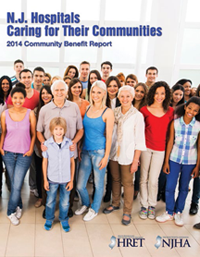NJHA’s Community Benefit Report 2014
Community Benefit Report 2014” (“Report”) which contains information pertaining to the programs, services and economic benefit New Jersey hospitals provided to the community in 2013.
The Report includes information from 60 hospitals in New Jersey, 58 of which are acute care, and indicates that in 2013, excluding healthcare services provided to their patients, $2.8 billion was provided in added benefits by these hospitals to their communities. Consistent with past years, wherever possible, NJHA utilized the standard reporting categories recommended by the Catholic Health Association and the Veteran’s Health Administration when analyzing the data. The amounts included in the Report were extrapolated for each category by taking the total for each category and dividing by the total number of beds represented and multiplying this amount by the total number of beds on a statewide basis.The programs and services discussed in the Report are combined into four main categories as follows:
- Unpaid Costs of Patient Care,
- Community Health Improvement Services,
- Health Professions Education, and
- Other Community Benefit Services and Programs.
UNPAID COSTS OF PATIENT CARE
The Report notes that, in 2013, the estimated amount for unpaid costs of patient care for New Jersey hospitals was $2.26 billion (see detailed breakdown below). The data collected for this category represents unpaid costs of acute care hospitals during the fiscal year July 2012 through June 2013, or calendar year 2013. The charity care shortfalls included in the report represent fiscal year 2013. The unpaid cost of Medicaid/Medicare represents only the inpatient fee-for-service population and was calculated using the Uniform Billing discharge data for 2013.
As part of their mission and also mandated by the state’s charity care laws, New Jersey hospitals provide necessary medical treatment to all patients regardless of their ability to pay. New Jersey hospitals receive reimbursement rates that are well below actual costs from government healthcare programs, such as charity care, Medicare and Medicaid. The expense for unpaid costs of charity, Medicare and Medicaid amounted to $550.7 million, $122.9 million and $364.1 million; respectively. In addition to the amounts noted above, New Jersey hospitals incurred charges of $1.22 billion for patient bad debts at cost.
The calculation of unpaid costs of patient care follows the American Hospital Association’s calculation of community benefit, whereby Medicare shortfall and bad debts are included. For purposes of the Form 990, Schedule H, Part I community benefit calculation, the Internal Revenue Service has adopted the Catholic Health Association model whereby Medicare shortfall and bad debt are not included as community benefit.
COMMUNITY HEALTH IMPROVEMENT SERVICES
According to the Report, this category “encompasses community programs that focus on health education, treatment and prevention”. During 2013, New Jersey hospitals provided more than 2,500 programs of this nature which resulted in 12.5 million individual encounters at an approximate value of $58.7 million.
The Report contains information discussing some specific programs which various organizations have undertaken in their respective communities. It highlights areas of identified need and how organizations are engaging the community to meet those needs.
HEALTH PROFESSIONS EDUCATION
“Health professions education includes scholarships and on-site clinical training and residency programs for future physicians, nurses and other healthcare professionals”. New Jersey hospitals recognize the importance of providing education and training as vital to the future of the healthcare workforce. According to the Report, New Jersey has 42 teaching hospitals which spent almost $138.5 million in 2013 on healthcare professions education. Additionally, during 2013, New Jersey hospitals provided scholarships of $63,094 to 172 aspiring healthcare professionals.
OTHER COMMUNITY PROGRAMS
“Other community benefit programs include initiatives that identify a unique community need — such as local safety partnerships, literacy programs and contributions toward municipal services.” In addition to all of the other programs and services that New Jersey hospitals make available to the community, they also provide subsidized health services and participate and underwrite other means-tested government programs, community building activities and community benefit operations. During 2013, the total value of all additional community programs provided by New Jersey hospitals was $355.9 million.
OTHER INDIRECT BENEFITS TO THE ECONOMY
In addition to the community benefit provided by New Jersey hospitals which is outlined above, during 2013, New Jersey hospitals provided 144,000 jobs and contributed $21 billion to state and local economies, including $8.3 billion in employee wages and $2.8 billion in goods and services purchased from other companies.
 View the full NJ Hospital’s 2014 Community Benefit Report
View the full NJ Hospital’s 2014 Community Benefit Report
Ask Our Experts
Please contact a member of WS+B’s Healthcare Services Group at [email protected] for further questions or assistance.
The information contained herein is not necessarily all inclusive, does not constitute legal or any other advice, and should not be relied upon without first consulting with appropriate qualified professionals for your individual facts and circumstances.


